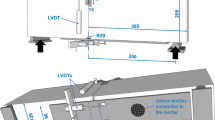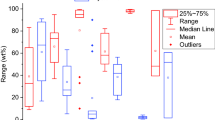Abstract
In this paper, the effects of the use of metakaolin instead of cement on the mechanical properties of mortars, high temperature, alkali–silica reaction, resistance to sulfate, absorption capacity and permeability were studied. In the study, 0, 5, 10, 15 and 20 % cement was replaced by metakaolin by weight to design five different types of mortar. 1-, 3-, 7-, 28-, 56-, 90- and 180-day compressive and flexural strengths and 28-day absorption capacity were determined. Similarly, compressive strength loss in mortar exposed to 200, 500 and \({700\,^\circ{\rm C}}\) for 3 h was determined. The resistance of mortars containing metakaolin to sulfate and alkali silica reaction was determined in accordance with ASTM C 1012 and ASTM C 1260 standards, respectively. It was found that the use of metakaolin had a positive effect on the mechanical properties of the mortars positively and that it reduced the absorption capacity and degrees of expansion caused by ASR and sulfate attack.

Similar content being viewed by others
References
Zhang, M.H., Malhotra, V.M.: Characteristics of a thermally activated alumino-silicate pozzolanic material and its use in concrete. Cem. Concr. Res. 25(8), 1713–1725 (1995)
Sabir, B.B., Wild, S., Bai, J.: Metakaolin and calcined clays as pozzolans for concrete: a review. Cem. Concr. Compos. 23, 441–454 (2001)
Siddique, R., Kalus, J.: Influence of metakaolin on the properties of mortar and concrete: a review. Appl. Clay Sci. 43, 392–400 (2009)
Khatib, J.M., Hibbert, J.J.: Selected engineering properties of concrete incorporating slag and metakaolin. Constr. Build. Mater. 19, 460–472 (2005)
Khatib, J.M., Wild, S.: Sulfate resistance of metakaolin mortar. Cem. Concr. Res. 28, 120–132 (1998)
Khatib, J.M., Clay, R.M.: Absorption characteristics of metakaolin concrete. Cem. Concr. Res. 4, 19–29 (2004)
Kim, H., Lee, S., Moon, H.: Strength properties and durability aspects of high strength concrete using korean metakaolin. Constr. Build. Mater. 21(6), 1229–1237 (2007)
Mermerdaş, K., Gesoğlu, M., Güneysi, E., Özturan, T.: Strength development of concretes incorporated with metakaolin and different types of calcined kaolins. Constr. Build. Mater. 37, 766–774 (2012)
Ramezanianpour, A.A., Jovein, H.B.: Influence of metakaolin and silica fume on the heat of hydration and compressive strength development of mortar. Appl. Clay 53(4), 704–708 (2011)
Güneysi, E., Gesoğlu, M., Karaoğlu, S., Mermerdaş, K.: Strength, permeability and shrinkage cracking of silica fume and metakaolin concretes. Constr. Build. Mater. 34, 120–130 (2012)
Shorky, H., Kotkata, M.F., Abo-el-Enein, S.A., Morsy, M.S.: Flexural strength and physical properties of fiber reinforced nano metakaolin cementitious surface compound. Constr. Build. Mater. 43, 453–460 (2013)
Badogiannis, E., Papadakis, V.G., Chaniotakis, E., Tsivilis, S.: Exploitation of poor greek kaolins: strength development of metakaolin concrete and evaluation by means of k value. Cem. Concr. Res. 34, 1035–1041 (2004)
TS EN 196-1: Methods of Testing Cement-Part 1: Determination of Strength. Turkish Standards Institute, Ankara (2002)
TS 12390-7: Testing Hardened Concrete-Part 7: Density of Hardened Concrete. Turkish Standards Institute, Ankara (2010)
ASTM C1012-10: Standard Test Method for Length Change of Hydraulic-Cement Mortars Exposed to a Sulfate Solution, Annual Book of ASTM Standards (1989)
ASTM C1260-07: Standard Test Method for Potential Alkali Reactivity of Aggregates (mortar-bar method). Annual Book of ASTM Standards (1994)
Khatib, J.M.: Metakaolin concrete at a low water to binder ratio. Constr. Build. Mater. 22, 1691–1700 (2008)
Tosun, K.; Felekoğlu, B.;Baradan, B.: Effects of metakaolin and silica fume on mechanical and physical effects of cement mortars. In: 3rd International Symposium on Sustainability in Cement and Concrete, TCMA, Istanbul, Turkey, pp. 83–94 (2007)
Poon, C.S., Azhar, S., Anson, M., Wong, Y.L.: Performance of metakaolin concrete at elevated temperatures. Cem. Concr. Compos. 25, 83–89 (2003)
Mehta, P.K.;Monterio, P.J.M.: Concrete microstructure, properties and materials, Chapter 8: Admixtures, Indian Concrete Chennai, pp. 256–271 (1997)
C1157/C1157M-11: Standard Performance Specification for Hydraulic Cement. Annual Book of ASTM Standards (2011)
Al-Akhras, N.M.: Durability of metakaolin concrete to sulfate attack. Cem. Concr. Res. 36, 1727–1734 (2006)
Ramlochan, T., Thomas, M., Gruber, K. A.: Effect of metakaolin on alkali–silica reaction in concrete. Cem. Concr. Res. 30(3), 339–344 (2006)
Author information
Authors and Affiliations
Corresponding author
Rights and permissions
About this article
Cite this article
Yazıcı, Ş., Arel, H.Ş. & Anuk, D. Influences of Metakaolin on the Durability and Mechanical Properties of Mortars. Arab J Sci Eng 39, 8585–8592 (2014). https://doi.org/10.1007/s13369-014-1413-z
Received:
Accepted:
Published:
Issue Date:
DOI: https://doi.org/10.1007/s13369-014-1413-z




